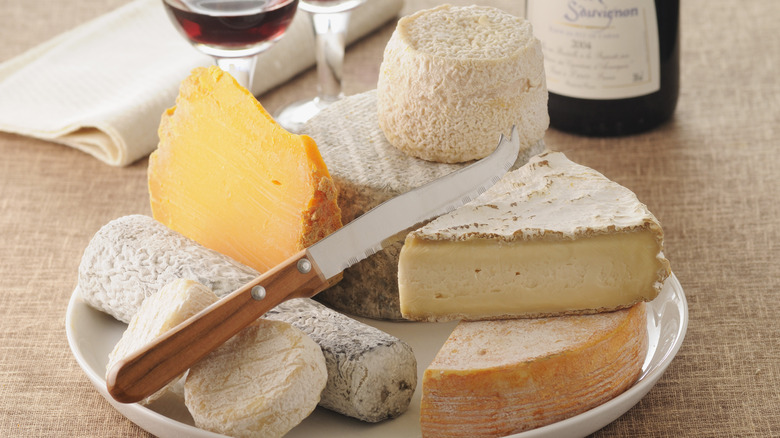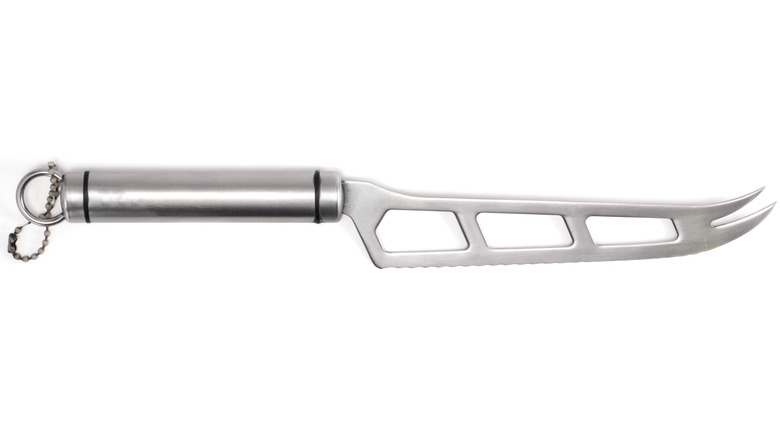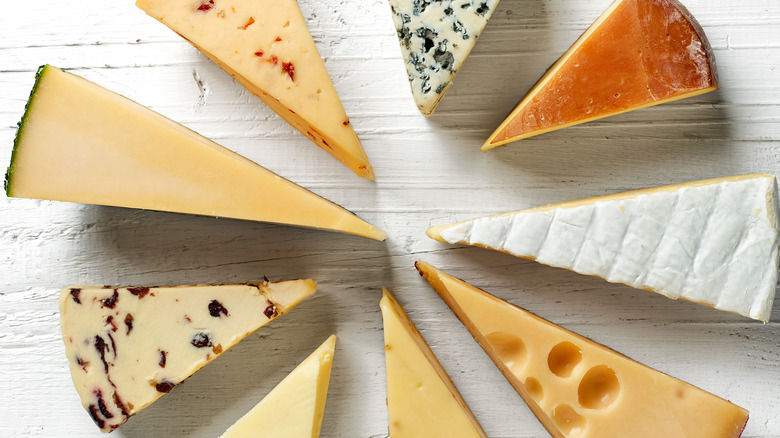The Golden Rule For Slicing Different Cheese Shapes (Like Wedges, Rounds And More)
It's tough to avoid charcuterie boards when they're everywhere. What was once a simple meat-and-cheese tray sitting on the sideboard of parties has taken center stage, and for good reason. The word "charcuterie" sounds like a massive upgrade. No cooking is involved; you just need to plan a charcuterie board shopping list.
This resurgence of an age-old habit of serving preserved and cured food has become a social media phenomenon. Kids who grew up pulling Lunchables out of a sack lunch now relish making their grown-up, sophisticated versions of those lunchbox favorites.
Pre-sliced cheeses aren't excluded from charcuterie boards. But there's more than one good reason to slice your own cheese. You'll achieve a greater variety of cheeses by broadening the options beyond the cheddar, muenster, and Swiss cheese varieties available in slices. Slicing your own will also allow for a variety of shapes. Shape matters, not just for visual appeal, but to maximize the number of slices you can serve. Plus, in the case of cheese with an edible rind, like brie, you'll want to ensure that it's distributed evenly.
The right tool for the job
Slicing cheese with a paring knife or chef's knife is certainly possible, but there's a better way. What makes a skeleton knife, so ideal for cutting cheese is the same thing that makes it looks so strange. It's not a gimmick; those holes make for a smaller area for the cheese to stick. That allows for neat, clean slices that don't require constant knife cleaning. Other tools are designed for cheese slicing, but this knife is the best place to start.
Until you become proficient at cheese slicing, there will probably be some slices that are a mess and won't make the cut for a perfect charcuterie board. Even if every slice is ideal, there's probably some leftover cheese. Don't despair; there are two great options for any cheese scraps.
You can follow Jacques Pepin's go-to method for re-inventing leftover cheese scraps. Fromage fort is a classic French technique of turning any cheese into a strongly-flavored spread that he dollops onto soup, serves with pasta, or spreads onto toast. A small crock of fromage fort would be a unique addition to your next charcuterie board. If you love stinky cheese, you'll love this very adult cheese spread.
If fromage fort isn't your thing, you can tame the funk by baking it into a mellower version. If it's still not for you after that, those scraps of cheese deserve a second life as fondue. Who doesn't love fondue?
How to enact the golden rule for slicing cheese
There's plenty of science behind why cheese is created in a wheel form. But some cheeses, especially fresh cheese, can come in various shapes. No matter the form, there's a way to slice that shape. Fromage From Europe explains how to tackle the various shapes. Thankfully, these golden rules are easy to navigate.
Flat, round cheese should be treated like a pie and cut into wedges. If that round is large enough, those wedges can be split up by slicing off the triangular tip, slicing parallel with the rind until you get close enough to the edge for appropriately sized pieces, then cutting those perpendicular to the rind.
Square or rectangular cheeses should be divided on the diagonal, creating wedges that might need to be divided up similarly to the round cheese if it's too large. Conical, or pyramids of cheese, should be sliced into wedges, too. Small cylinders of cheese can be sliced into rounds. Even ball-shaped cheeses should be cut into wedges, like the segments of an orange.
Ultimately, it's all about even-sized portions that ensuree no slice is all rind. For more visual aids and slight variations on these techniques, Wisconsin Cheese provides its take on the golden rule.


